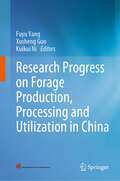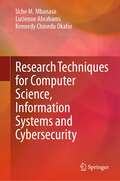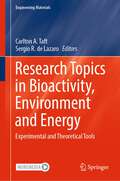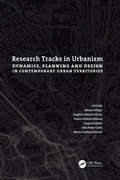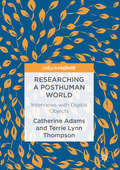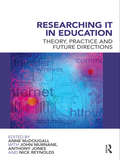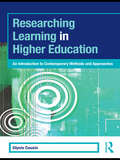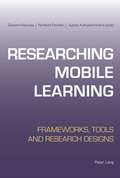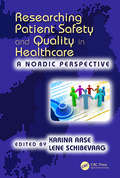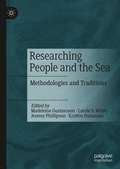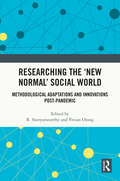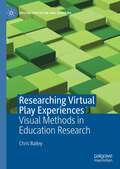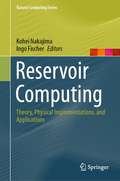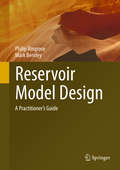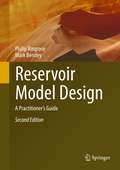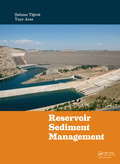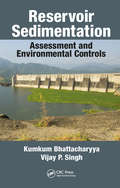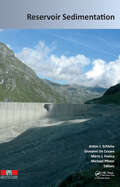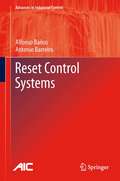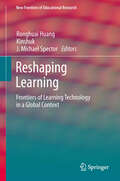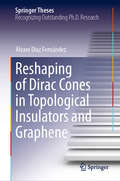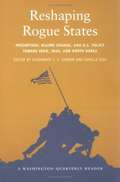- Table View
- List View
Research Progress on Forage Production, Processing and Utilization in China
by Fuyu Yang Xusheng Guo Kuikui NiThis book has 11 chapters which systematically introduce the latest achievements in scientific research and technological application of the forage industry in China, and also cover the laws and polices related to forage production. The main focus of this monograph is the progress of forage science in China. Each chapter in this book contains numerous charts and diagrams further illustrating the impact of development activities in the area. It is the first book in its field and compiled by mobilizing all the research forces in the field of forage grass and under the leadership of China Agricultural University, Lanzhou University, and Sichuan Academy of Grassland Sciences with the support of other related universities and research institutes. China is the largest forage consumption country in the world. Every year, more than 2 billion herbivorous livestock need more than 350 million tons of forage but the supply each year is only 250 million tons. With the policy and financial support of the Central Government, the forage industry in China has been developed rapidly, great progress has been made in the science and technology in forage production, processing, and utilization, and its influence has been increased in the world.
Research Techniques for Computer Science, Information Systems and Cybersecurity
by Uche M. Mbanaso Lucienne Abrahams Kennedy Chinedu OkaforThis book introduces impact-driven research paths in computer science, information systems and cybersecurity with practical insights, effective instructions, and examples. The book takes the students through the full cycle of research until the point of submission and evaluation. The book begins by providing postgraduate research students with the foundational concepts and techniques to simplify the complexities associated with choosing topics in the computer science (CS), information systems (IS) and cybersecurity (CY) research domains. The authors furnish readers with fundamentals that facilitate active quantitative, qualitative, and mixed methods research enquiries. The content offers important perspectives on how to think about deepening research in CS, IS and CY, noting that these subjects can be studied from computational sciences, engineering sciences, health sciences, social sciences, or interdisciplinary perspectives. This unique and contemporary book aims to benefit researchers, graduate students and engineers in the fields of computer science, information systems and cybersecurity in particular, in addition to other engineering and technology disciplines.ctives on how to think about deepening research in CS, IS and CY, noting that these subjects can be studied from computational sciences, engineering sciences, health sciences, social sciences, or interdisciplinary perspectives. This unique and contemporary book aims to benefit researchers, graduate students and engineers in the fields of computer science, information systems and cybersecurity in particular, in addition to other engineering and technology disciplines.ctives on how to think about deepening research in CS, IS and CY, noting that these subjects can be studied from computational sciences, engineering sciences, health sciences, social sciences, or interdisciplinary perspectives. This unique and contemporary book aims to benefit researchers, graduate students and engineers in the fields of computer science, information systems and cybersecurity in particular, in addition to other engineering and technology disciplines.ctives on how to think about deepening research in CS, IS and CY, noting that these subjects can be studied from computational sciences, engineering sciences, health sciences, social sciences, or interdisciplinary perspectives. This unique and contemporary book aims to benefit researchers, graduate students and engineers in the fields of computer science, information systems and cybersecurity in particular, in addition to other engineering and technology disciplines.ctives on how to think about deepening research in CS, IS and CY, noting that these subjects can be studied from computational sciences, engineering sciences, health sciences, social sciences, or interdisciplinary perspectives. This unique and contemporary book aims to benefit researchers, graduate students and engineers in the fields of computer science, information systems and cybersecurity in particular, in addition to other engineering and technology disciplines.ctives on how to think about deepening research in CS, IS and CY, noting that these subjects can be studied from computational sciences, engineering sciences, health sciences, social sciences, or interdisciplinary perspectives. This unique and contemporary book aims to benefit researchers, graduate students and engineers in the fields of computer science, information systems and cybersecurity in particular, in addition to other engineering and technology disciplines.
Research Topics in Bioactivity, Environment and Energy: Experimental and Theoretical Tools (Engineering Materials)
by Carlton A. Taft Sergio R. de LazaroThis book covers edge-point applications in science and engineering. The chapters discuss the functional properties of advanced engineering materials and biomolecules, improving the comprehension of their chemical physical properties and potential for new technological and medicinal applications. The book presents a small number of experimental techniques and computational simulation models from basic concepts of classical/quantum mechanics, physics, chemistry, biology, statistical methods that can predict important applications and properties of these materials/biomolecules. The content shows how improving design of new systems helps in addressing future world problems (health, energy, food, environment, transportation, housing, clothing, etc.), i.e., almost every aspects of our daily lives.
Research Tracks in Urbanism: Dynamics, Planning and Design in Contemporary Urban Territories
by Alessia AllegriMaybe the Global Village metaphor has never been more accurate than it is today, where societies join forces in the fight against the COVID 19 pandemic, in a global coordinated effort, possibly never tested before in the known history of Humankind. Although we are sure that in the past some other shared demands have united the different peoples of the world, this has never been so strongly necessary, mainly in what the global scientific community is concerned. This is a fight for the survival of a society. However, we should not lose sight of what we are fighting for. We fight together for people. Not just for the abstract value of Human life, but for life in society as a whole, including its moral and ethical aspects. The topics of this book are based on this claim, on what makes it possible. We do not build our lives in a vacuum, or in distant Invisible Cities, but through a higher value, which represents physical life in society: the City, built by the discipline of Urbanism. This book is a spin-off of the International Research Seminar on Urbanism_SIIU2020. Inspired by the contents of twelve research seminars, a group of researchers from the universities of Barcelona, Lisbon and São Paulo discuss the contemporary agenda of research in Urbanism. Following the conference, a selection of 35 original double-blind peer-reviewed research papers were brought together with different perspectives about such an agenda.
Researching a Posthuman World
by Catherine Adams Terrie Lynn ThompsonThis book provides a practical approach for applying posthumanist insights to qualitative research inquiry. Adams and Thompson invite readers to embrace their inner - and outer - cyborg as they consider how today's professional practices and everyday ways of being are increasingly intertwined with digital technologies. Drawing on posthuman scholarship, the authors offer eight heuristics for "interviewing objects" in an effort to reveal the unique - and sometimes contradictory - contributions the digital is making to work, learning and living. The heuristics are drawn from Actor Network Theory, phenomenology, postphenomenology, critical media studies and related sociomaterial approaches. This text offers a theoretically informed yet practical approach for asking critical questions of digital and non-digital things in professional and personal spaces, and ultimately, for considering the ethical and political implications of a technology mediated world. A thought-provoking and innovative study, this book will be of great interest to scholars and researchers of technology studies, digital learning, and sociology.
Researching a Posthuman World: Interviews with Digital Objects
by Catherine Adams Terrie Lynn ThompsonThis book provides a practical approach for applying posthumanist insights to qualitative research inquiry. Adams and Thompson invite readers to embrace their inner – and outer – cyborg as they consider how today’s professional practices and everyday ways of being are increasingly intertwined with digital technologies. Drawing on posthuman scholarship, the authors offer eight heuristics for “interviewing objects” in an effort to reveal the unique – and sometimes contradictory – contributions the digital is making to work, learning and living. The heuristics are drawn from Actor Network Theory, phenomenology, postphenomenology, critical media studies and related sociomaterial approaches. This text offers a theoretically informed yet practical approach for asking critical questions of digital and non-digital things in professional and personal spaces, and ultimately, for considering the ethical and political implications of a technology mediated world. A thought-provoking and innovative study, this book will be of great interest to scholars and researchers of technology studies, digital learning, and sociology.
Researching IT in Education: Theory, Practice and Future Directions
by Anne McDougallSerious criticisms of research on IT in education have been published recently in both the UK and the USA. Researching IT in Education aims to provoke thought and discussion among practising researchers by considering a range of approaches to undertaking quality research. Establishing priorities and directions for future research in the sub-discipline of IT in education, the book is structured around five foci: theory history research directions methodology research topics. This book argues for the enormous power of IT to enable fundamental research that both refines and develops theory and practice in education. High quality research that advances knowledge and educational practice in this area will generally require longer timelines and more complex data collection and analysis methods. The authors draw attention to the value of theoretical frameworks used in mainstream educational research and highlight the early theoretical work on the subject of IT in education. Researching IT in Education is the only book in its area to focus on methodological and research design issues. The individual chapters are contributed by expert researchers and leaders in the field from ten countries, thus providing an unusually broad but coherent international set of perspectives for the issues examined in the book. This book will benefit anyone interested in or undertaking research on IT in education, including academics, research students, teachers and policy-makers.
Researching Learning in Higher Education: An Introduction to Contemporary Methods and Approaches (SEDA Series)
by Glynis CousinAcross the world, universities are transforming their teaching and learning practices to meet the challenges facing Higher Education in the 21st century. Research into teaching and learning in Higher Education has never been a more important issue. Growing numbers of academics across disciplines are conducting research in their teaching. This book presents contemporary approaches to researching university teaching and learning to address this rising demand. The author provides a much needed comprehensive yet basic approach for conducting this type of research. A perfect resource for new lecturers, professional developers, researchers and graduate students; this book provides useful and effective guidance for conducting teaching and learning research in Higher Education. Filling a clear gap in the market, this book covers all the essential methodological and theoretical bases needed to engage in Higher Education research. This book offers a refreshingly light yet serious approach to research which has proved to yield significant advances in the field, allowing new academics from any discipline to effectively conduct higher education research. Each chapter covers the following: FRAMING HIGHER EDUCATION RESEARCH Generating an ETHICAL FRAMEWORK QUALITATIVE DATA ANALYSIS FOCUS GROUP RESEARCH SEMI-STRUCTURED INTERVIEWS NARRATIVE INQUIRY ETHNOGRAPHIC APPROACHES CASE STUDY RESEARCH ACTION RESEARCH APPRECIATIVE INQUIRY PHENOMENOGRAPHY RESEARCHING THRESHOLD CONCEPTS VISUAL RESEARCH EVALUATION APPROACHES This book is an invaluable resource for anyone interested in up to date theories and methods for conducting teaching and learning research in Higher Education.
Researching Mobile Learning: Frameworks, Tools and Research Designs, Third Unrevised Edition
by Giasemi Vavoula Norbert Pachler Agnes Kukulska-HulmeThis book sets out the issues and requirements for mobile learning research, and presents recent efforts to specify appropriate theoretical frameworks, research methods and tools.
Researching Patient Safety and Quality in Healthcare: A Nordic Perspective
by Karina Aase Lene SchibevaagResearching Patient Safety and Quality in Health Care: A Nordic Perspective is an anthology based on contributions from leading researchers on quality and safety in healthcare in the Nordic countries together with four internationally renowned patient safety authors. Research on patient safety and quality has been dominated by countries such as the USA, England, Canada, and Australia. This book addresses the current debates in research on patient safety and quality in healthcare from a Nordic perspective. What are the flavours of Nordic research within these topics? What does it add to the international research literature? This book illustrates the unique nature of researching patient safety and quality with the Nordic perspective as well as showcasing representative work. The book presents an overview of the status and evidence of international and Nordic research on quality and safety in healthcare. Four different perspectives are used to present the trends within the research field: a patient perspective, a methodological perspective, a theoretical perspective, and a clinical perspective. The book then presents the status of Nordic research in the field and displays a set of illustrative work and current research topics within the Nordic context, concluding with a discussion of the characteristic features of Nordic research on patient safety and quality in healthcare. The anthology presents an inter-professional perspective and researchers from disciplines such as medical and nursing sciences, humanities, social sciences and engineering. It is written to contribute to the patient safety cause with translational knowledge that will be useful to researchers, policy makers and healthcare managers within Nordic countries and internationally.
Researching People and the Sea: Methodologies and Traditions
by Madeleine Gustavsson Carole S. White Jeremy Phillipson Kristen OunanianIn this unique edited collection, social scientists reflect upon and openly share insights gathered from researching people and the sea. Understanding how people use, relate to and interact with coastal and marine environments has never been more important, with social scientists having an increasingly vital contribution to make. Yet practical experiences in deploying social science approaches in this field are typically hidden away in field notes and unpublished doctoral manuscripts, with the opportunity for shared learning that comes from doing research often missed. There is a need for reflection on how social science knowledge is produced. This collection presents experiences from the field, its necessary reflexivity and innovation in methods, and the challenges and opportunities of translating across disciplines and policy. It brings to light the tacit expertise needed to study people and the sea and offers lessons which readers could employ in their own research. With a focus on the future direction of marine social sciences, the volume is highly relevant to masters and doctoral students and more experienced researchers engaged in studying people and the sea, as well as policy makers, practitioners and scientists wishing to understand the social dimension of marine and coastal environments. Chapters 2 and 3 are available open access under a Creative Commons Attribution 4.0 International License via link.springer.com.
Researching the ‘New Normal’ Social World: Methodological Adaptations and Innovations Post-Pandemic
by R. Sooryamoorthy Vivian OjongThis edited volume focuses on the changing research methodologies in social science research, prompted by the new social world shaped by the pandemic. It explores adaptations and developments to meet the demands of transforming social circumstances and showcases innovative alternative approaches. Featuring a range of international and interdisciplinary contributors who discuss the context of social science research in the "new normal", the book sets out the need to redesign research to address present-day challenges for the post-pandemic. Chapters share methodological innovations and demonstrate how applicable these new and adapted methodologies are to a world post-pandemic, discussing a wide range of innovative, digital-first research methods with practical analysis. The role of technology and its application in social science research during this transition is explored in particular, alongside new approaches to quantitative and qualitative research that feature innovations in ethnography, online data collection, and ethical protocols for research. Ultimately offering a comprehensive exploration of adaptive and innovative social science research methodologies suited to the current social context, the book will be relevant to researchers, academics, and scholars in the fields of research methods, research technologies, and the sociology of education.
Researching Virtual Play Experiences: Visual Methods in Education Research (Digital Education and Learning)
by Chris BaileyThis book illuminates the lived experience of a group of primary school children engaged in virtual world play during a year-long after-school club. Shaped by post-structuralist theory and New Literacy Studies, it outlines a playful, participatory and emergent methodological approach, referred to as ‘rhizomic ethnography’. This ‘hybrid’ text uses both words and images to describe the fieldsite and the methodology, demonstrating how children’s creation of a digital community through Minecraft was shaped by the both the game and their wider social and cultural experiences. Through the exploration of various dimensions of the club, including visual and soundscape data, the author demonstrates the ‘emergent dimension of play’. It will be of interest and value to researchers of children’s play, as well as those who explore visual methods and design multimodal research outputs.
Reservoir Computing: Theory, Physical Implementations, and Applications (Natural Computing Series)
by Kohei Nakajima Ingo FischerThis book is the first comprehensive book about reservoir computing (RC). RC is a powerful and broadly applicable computational framework based on recurrent neural networks. Its advantages lie in small training data set requirements, fast training, inherent memory and high flexibility for various hardware implementations. It originated from computational neuroscience and machine learning but has, in recent years, spread dramatically, and has been introduced into a wide variety of fields, including complex systems science, physics, material science, biological science, quantum machine learning, optical communication systems, and robotics. Reviewing the current state of the art and providing a concise guide to the field, this book introduces readers to its basic concepts, theory, techniques, physical implementations and applications.The book is sub-structured into two major parts: theory and physical implementations. Both parts consist of a compilation of chapters, authored by leading experts in their respective fields. The first part is devoted to theoretical developments of RC, extending the framework from the conventional recurrent neural network context to a more general dynamical systems context. With this broadened perspective, RC is not restricted to the area of machine learning but is being connected to a much wider class of systems. The second part of the book focuses on the utilization of physical dynamical systems as reservoirs, a framework referred to as physical reservoir computing. A variety of physical systems and substrates have already been suggested and used for the implementation of reservoir computing. Among these physical systems which cover a wide range of spatial and temporal scales, are mechanical and optical systems, nanomaterials, spintronics, and quantum many body systems. This book offers a valuable resource for researchers (Ph.D. students and experts alike) and practitioners working in the field of machine learning, artificial intelligence, robotics, neuromorphic computing, complex systems, and physics.
Reservoir Geomechanics
by Mark D. ZobackA practical reference for geoscientists and engineers in the petroleum and geothermal industries.
Reservoir Model Design
by Philip Ringrose Mark BentleyThis book gives practical advice and ready to use tips on the design and construction of subsurface reservoir models. The design elements cover rock architecture, petrophysical property modelling, multi-scale data integration, upscaling and uncertainty analysis. Philip Ringrose and Mark Bentley share their experience, gained from over a hundred reservoir modelling studies in 25 countries covering clastic, carbonate and fractured reservoir types. The intimate relationship between geology and fluid flow is explored throughout, showing how the impact of fluid type, production mechanism and the subtleties of single- and multi-phase flow combine to influence reservoir model design. Audience: The main audience for this book is the community of applied geoscientists and engineers involved in the development and use of subsurface fluid resources. The book is suitable for a range of Master's level courses in reservoir characterisation, modelling and engineering. · Provides practical advice and guidelines for users of 3D reservoir modelling packages · Gives advice on reservoir model design for the growing world-wide activity in subsurface reservoir modelling · Covers rock modelling, property modelling, upscaling and uncertainty handling · Encompasses clastic, carbonate and fractured reservoirs
Reservoir Model Design: A Practitioner's Guide
by Philip Ringrose Mark BentleyThis book gives practical advice and ready to use tips on the design and construction of subsurface reservoir models. The design elements cover rock architecture, petrophysical property modelling, multi-scale data integration, upscaling and uncertainty analysis. Philip Ringrose and Mark Bentley share their experience, gained from over a hundred reservoir modelling studies in 25 countries covering clastic, carbonate and fractured reservoir types, and for a range of fluid systems – oil, gas and CO2, production and injection, and effects of different mobility ratios. The intimate relationship between geology and fluid flow is explored throughout, showing how the impact of fluid type, displacement mechanism and the subtleties of single- and multi-phase flow combine to influence reservoir model design.The second edition updates the existing sections and adds sections on the following topics:· A new chapter on modelling for CO2 storage· A new chapter on modelling workflows· An extended chapter on fractured reservoir modelling· An extended chapter on multi-scale modelling· An extended chapter on the quantification of uncertainty· A revised section on the future of modelling based on recently published papers by the authorsThe main audience for this book is the community of applied geoscientists and engineers involved in understanding fluid flow in the subsurface: whether for the extraction of oil or gas or the injection of CO2 or the subsurface storage of energy in general. We will always need to understand how fluids move in the subsurface and we will always require skills to model these quantitatively. The second edition of this reference book therefore aims to highlight the modelling skills developed for the current energy industry which will also be required for the energy transition of the future. The book is aimed at technical-professional practitioners in the energy industry and is also suitable for a range of Master’s level courses in reservoir characterisation, modelling and engineering.• Provides practical advice and guidelines for users of 3D reservoir modelling packages• Gives advice on reservoir model design for the growing world-wide activity in subsurface reservoir modelling• Covers rock modelling, property modelling, upscaling, fluid flow and uncertainty handling• Encompasses clastic, carbonate and fractured reservoirs • Applies to multi-fluid cases and applications: hydrocarbons and CO2, production and storage; rewritten for use in the Energy Transition.
Reservoir Sediment Management
by Sahnaz Tigrek Tuce ArasSiltation in reservoirs has become an important problem when dams are getting older and stop functioning when the sediment has accumulated to a certain extent. With proper sediment management techniques, negative effects of sediment can be avoided and reservoir life and performance can be improved.This volume deals with reservoir sedimentation, dep
Reservoir Sedimentation: Assessment and Environmental Controls
by Kumkum Bhattacharyya Vijay P. SinghReservoir Sedimentation: Assessment and Environmental Controls appraises the issues of sedimentation in reservoirs and discusses measures that can be employed for the effective management of sediment to prolong the operational life of reservoirs. It provides information for professional consultants and policymakers to enable them to manage dams in the best possible way, in order to ensure their sustainability as well as the sustainability of water resources in general. It examines the effects of anthropogenic intervention and management of sediment in dams and reservoirs, as water resources become more sensitive and the demand for clean water continues to increase. Features: Examines the issue of sedimentation in dams and reservoirs and presents water management strategies to alleviate environmental issues Presents methods to help ensure the environmental sustainability of dams and reservoirs, as well as the sustainability of water resources- with consideration of climate change and increased demand Illustrates the spatial distribution of sedimentation characteristics for several dams using geographic information systems (GIS) Explains the relationships between loss in capacity and catchment characteristics Examines regional variation in sediment yield, defines geomorphic regions on the basis of similar hydrometeorology, physiography, geology, and vegetation affecting reservoirs
Reservoir Sedimentation
by Anton J. Schleiss Giovanni De Cesare Mário J. Franca Michael PfisterDespite the mechanisms of reservoir sedimentation being well known for a long time, sustainable and preventive measures are rarely taken into consideration in the design of new reservoirs. To avoid operational problems of powerhouses, sedimentation is often treated for existing reservoirs with measures which are efficient only for a limited time.
Reset Control Systems
by Antonio Barreiro Alfonso BañosReset Control Systems addresses the analysis for reset control treating both its basic form, and some useful variations of the reset action and reset condition. The issues regarding reset control - concepts and motivation; analysis tools; and the application of design methodologies to real-world examples - are given thorough coverage. The text opens with a historical perspective which moves from the seminal work of the Clegg integrator and Horowitz FORE to more recent approaches based on impulsive/hybrid control systems and explains the motivation for reset compensation. Preliminary material is also included. The focus then turns to stability analysis for systems using techniques which account for various time- and frequency-domain criteria. The final section of the book is centered on control systems design and application. The PI+CI compensator is detailed as are a proposed frequency domain approach using quantitative feedback theory and ideas for design improvement. Design examples are given.
Reshaping Environments: An Interdisciplinary Approach to Sustainability in a Complex World
by Helena BenderReshaping Environments: An Interdisciplinary Approach to Sustainability in a Complex World draws together a team of specialist authors from disciplines including urban planning, social sciences, engineering and environmental science to examine the diverse influences humans have upon the natural environment. This interdisciplinary approach presents multifaceted responses for complex environmental issues. The book explores current environmental science theories to provide a solid foundation of theoretical knowledge. Drawing on a range of case studies, it develops core analytical skills for application to real-world environmental issues. Reshaping Environments gives environmental science students the tools and insight to comprehend the range of influences society imposes on the natural environment. It is essential reading for those interested in creating a mutually beneficial future for human society and the natural environment.
Reshaping Learning
by Ronghuai Huang J. Michael Spector KinshukThis edited volume with selected papers from extinguished experts and professors in the field of learning technology and the related fields who are far-sighted and have his/her own innovative thoughts on the development of learning technology. This book will addresses the main issues concerned with the trend and future development of learning processes, innovative pedagogies changes, effects of new technologies on education, future learning content. Learning technology has been affected by advances in technology development and changes in the field of education. Nowadays we cannot afford to sense the changes and then make adaption to it. What we should do is to predict the changes and make positive and active reactions to help the trend go smoothly and in a more beneficial way. This book aims to gather the newest ideas on the frontiers and future development of learning education from the aspects of learning, pedagogies, and technologies in learning in order to draw a picture of learning education in the near future.
Reshaping of Dirac Cones in Topological Insulators and Graphene (Springer Theses)
by Álvaro Díaz FernándezDirac cones are ubiquitous to non-trivial quantum matter and are expected to boost and reshape the field of modern electronics. Particularly relevant examples where these cones arise are topological insulators and graphene. From a fundamental perspective, this thesis proposes schemes towards modifying basic properties of these cones in the aforementioned materials. The thesis begins with a brief historical introduction which is followed by an extensive chapter that endows the reader with the basic tools of symmetry and topology needed to understand the remaining text. The subsequent four chapters are devoted to the reshaping of Dirac cones by external fields and delta doping. At all times, the ideas discussed in the second chapter are always a guiding principle to understand the phenomena discussed in those four chapters. As a result, the thesis is cohesive and represents a major advance in our understanding of the physics of Dirac materials.
Reshaping Rogue States: Preemption, Regime Change, and U.S. Policy Toward Iran, Iraq, and North Korea
by Alexander T. J. Lennon Camille EissIn January 2002, President George W. Bush declared Iran, Iraq, and North Korea constituents of an "axis of evil."
